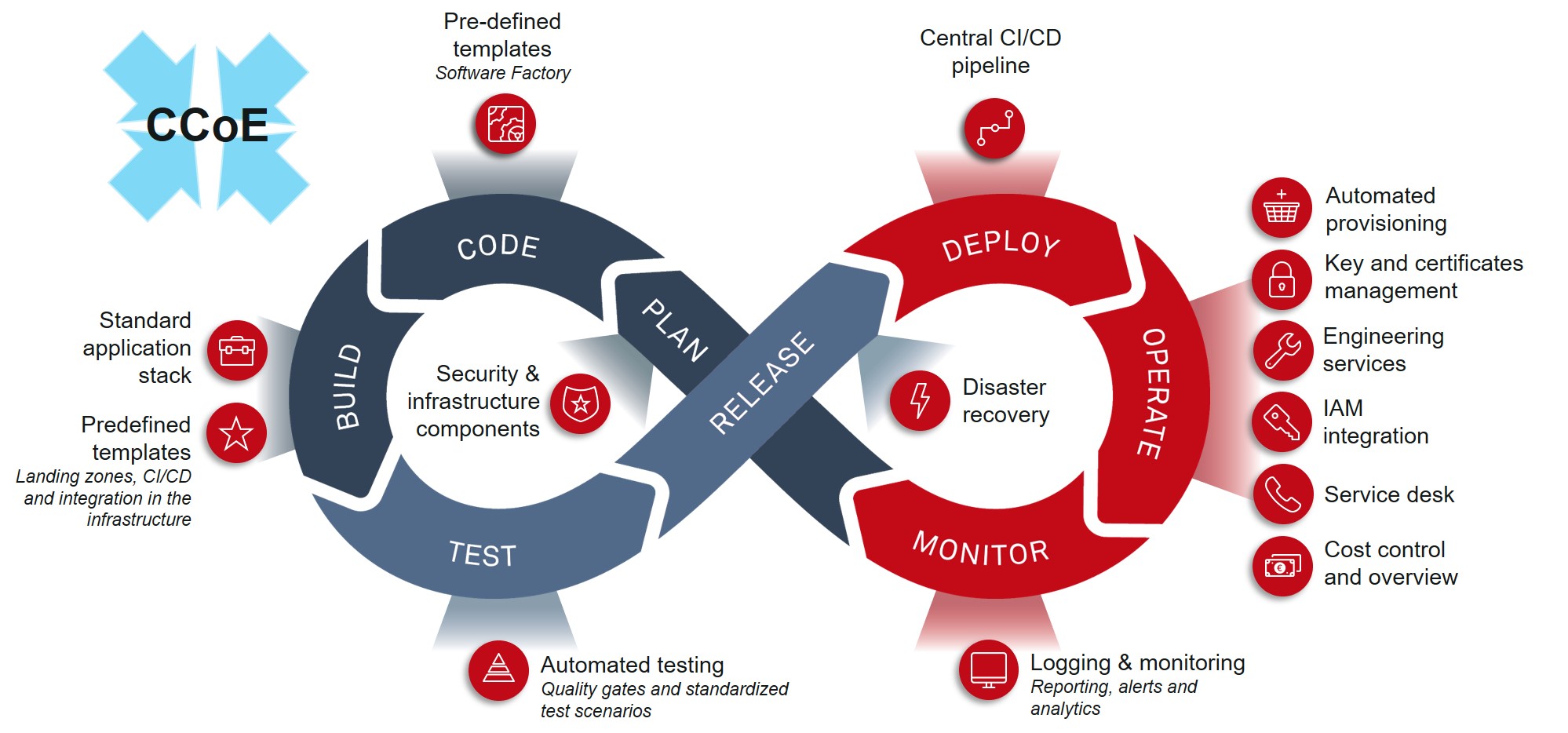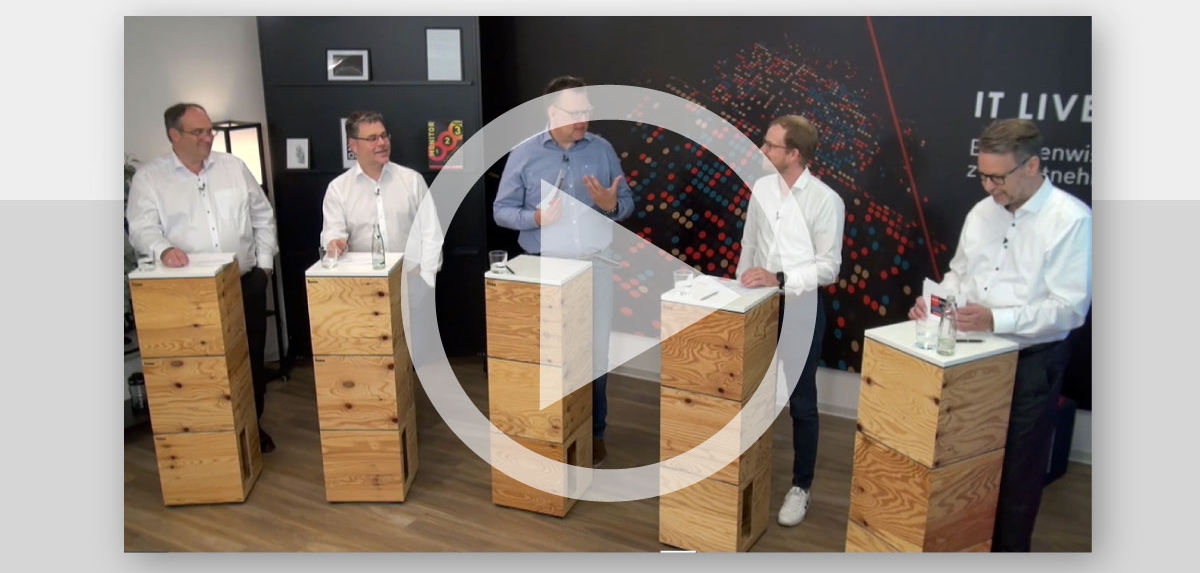Cloudification: Improved efficiency and growth through the cloud

Organizations are making the cloud an integral part of their IT strategy, looking to migrate not just new applications but also their existing IT systems to the cloud. We demonstrate how CIOs can plan a cloud strategy that takes into account every aspect of their business objectives, governance, migration, and operations.
The cloud offers greater flexibility and scalability while reducing the operational burden on your IT. For this to succeed, however, companies need to know exactly where they currently stand as well as their envisioned destination. Three cornerstones are essential during the intensive preparation and analysis for transition to the cloud.
- Build the skill set: In order to ensure that the cloud model operates effectively and that services are used efficiently within the company, IT staff will need to possess the appropriate skill set.
- Establish the cloud mindset: Companies should embrace the cloud as a vehicle for growth, for achieving strategic goals, and for general organizational improvement. For this to succeed, both IT and the business departments need to adopt the cloud mindset. Cloud projects require all-around, end-to-end change management.
- Develop a technical cloud framework: Which cloud service model, which services, and which cloud service providers do you want to use and how should they be orchestrated? The technical cloud framework is based on existing corporate governance structures and complies with statutory regulations. During this process, you will have to define access authorizations, cost accounting structures, and lifecycle management as well as draft a security concept for the use of your cloud services.
The first two elements can be viewed as the enablers for employees learning to find their way around. A framework provides parameters for the content of the cloud services. We recommend setting it up as a tailored, company-wide project so that user departments and IT all follow the same approach to the provision and use of IT services. If companies are late in getting business departments involved and fail to take their specific concerns sufficiently into account, costly adjustments may have to be made at a later date.
Materna has devised a procedure for CIOs that companies can work with to chart their own course into the cloud and towards further integration.
Phase 1: Cloud consulting and change management
Phase 1 kicks off with the Cloud Business Check to determine which areas can benefit from cloud services and deliver value to the business and that particular sector. The Cloud Business Check evaluates your starting point and looks at the business and the cloud together as a whole. Any cloud services already in use are also included in this assessment. Individual procedures are coordinated on the basis of know-how and the current cloud architecture.
The results of the Cloud Business Check will highlight the specific benefits of the cloud for your company. Regardless of whether the strategic decision has already been made or the groundwork is still in progress, a Cloud Business Check helps to define the preliminary parameters of your cloud strategy.
It is followed by a Cloud Readiness Assessment – a more detailed survey that examines in precisely which areas the cloud will improve customer satisfaction and, as the case may be, reduce costs. Questionnaires and semi-structured interviews concerning the important issues like strategy, organization, business processes and IT infrastructure are conducted company-wide. Using evaluation criteria, current and target status can then be compared.
The results documentation provides the CIO and senior management with an analysis of each aspect under consideration as well as recommendations for further action. These recommendations can then be used to work out the technological framework, skill set and change management you are aiming for, as well as specific content-related steps.
Phase 2: Cloud training and technical cloud enablement
The second phase involves turning these defined objectives into reality. This means developing the necessary expertise within the company, in addition to adopting the change management measures agreed upon and implementing the content-related steps as recommended in the Cloud Readiness Assessment, such as the migration of workloads or individual applications. Training sessions are held for all roles that were found to be in need of further coaching by the Skills Gap Analysis.
Armed with this knowledge, companies are then able to take the first steps towards a hybrid or multi-cloud platform that is aligned with their individual requirements and based on best practices. This is done in an agile process. A largely standardized approach is used to examine various areas and apply them across the company. This includes defining templates for landing zones, access authorisations, security mechanisms, cost management, a CI/CD pipeline and network settings. Following an agile approach means that the platform is constantly being reviewed, and any need for modifications taken into consideration.
 A typical cloud platform in the area of development for modern software packages
A typical cloud platform in the area of development for modern software packages
It is advisable to link this procedure with the IT service management systems so that users are able to use it as a resource for such actions as ordering virtual machines at short notice in the internal portal or reserving an office seat via the application running in the cloud.
The advantage for users: They have the convenience of being able to order all kinds of services through a user-friendly interface, without needing to understand the underlying structure of the cloud environment.
Phase 3: Continuous integration and managed service
The third phase focuses on the operating model of the cloud platform. Its complexity will vary depending on the customer's individual requirements.
- If special compliance requirements or regulations are prescribed for a company, compliance with these must be assured during operation.
- Monitoring requirements, whether technical or commercial, and their reporting or automated processing usually necessitate a bespoke solution that is centrally orchestrated in a multi-cloud scenario.
- Infrastructure as a Service involves more configuration work than Platform as a Service, but also offers users more options for accessing individual services.
- Applications evolve, but they can be simplified and improved through meaningful cloud services.
Operations should be considered in the context of managed services and continuous integration. Managed services and continuous integration are not mutually exclusive. A managed service centres around the running of operational services in the IaaS and PaaS environment. Continuous integration is the principle of continually developing specific applications and making them available to users, while ensuring that the resources on the cloud platform are used efficiently. An application may also consist only of infrastructure as code, i.e., the provision of workloads in the cloud through code.
Cloudification invigorates your business
The journey to the cloud is not a one-off project. The cloud is a vehicle for supporting business with the help of IT. In its traditional role as a service provider, the IT department has until now functioned largely on a reactive basis. A cloud platform helps IT to position itself as a technological driver within the company, identifying new business opportunities and ideas that can generate a competitive advantage. With a good cloud strategy, IT's attitude towards other business units changes from reactive to proactive and innovation is encouraged.
IT is constantly faced with coordinating a combination of different forms of resource provision. In hybrid and multi-cloud concepts, resources from on-premise systems need to be implemented in harmony with applications in public and private clouds, so that business functionality and legal requirements can be met in equal measure.
Through cloudification, CIOs are able to set a course for meeting these requirements in a way that makes the whole enterprise more agile.
Webcast: Application assessment - the optimized path to the cloud
 Watch the webcast with Materna and Txture
Watch the webcast with Materna and Txture
Did you miss our joint web session "Application assessment: the optimized path to the cloud" with Materna?
Watch the recroding hereMaterna & Txture
Through our partnership with Materna, we can provide our customers with an end-to-end cloud transformation management experience that includes faster transformation times, reduced costs, lower risks, and the proper toolset to conduct cloud transformations effectively.
Are you interested in how Txture and Materna can level up your cloud migration? Benefit from this bundled knowledge and shared experience. Reach out to us and start your journey to the cloud now!
Related posts
29.4.2025Application ModernizationDefine your scope for IT modernization2.3.2025
Cloud StrategySelecting the right cloud data center for hosting your workloads27.6.2024
Cloud optimizationA great driver to maximize cloud value: moving to instances with modern processors 24.5.2024
Cloud Knowledge5 best practices to manage change during a cloud transformation5.4.2024
Generative AIHow to welcome Generative AI into your existing tech ecosystem
